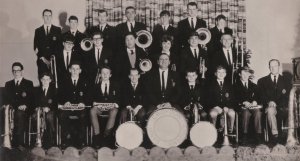
The Croydon Citizens' Brass Band in 1965
The Croydon Citizens’ Band was
formed in 1962 using instruments and music of the former Lillydale Shire
Band and members from the Lillydale Shire and Ferntree Gully Bands. The
new Brass Band rehearsed at what was then the Croydon Library. This
building, in Mt Dandenong Road, on the eastern side of the Croydon Hall is
now the Maroondah Citizens’ Advice Bureau.
The Band’s first Bandmaster was Ralph Williamson, who served until the
beginning of 1969. Amongst the founding members were Cr. G N Frost of
the newly established Shire of Croydon, who became the Band’s first
President and Bill Leggatt, a local resident of Croydon, who was very
community minded and later made a life member for his work with the Band.
Rehearsals were on Friday evenings.
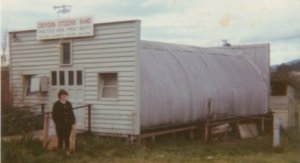
The Nissen Hut the Brass Band moved into in 1965
In June 1965 the Band moved to a Nissen Hut belonging to Joe and Ally Nicholas,
local nursery owners, on the corner of Bayswater and Eastfield Roads. The Band set
up lengthwise in the hut and, so the story goes, the bass players soon developed curvature
of the spine; however frequent marching practice tended to correct this condition.
After just four years of existence the Band found itself struggling financially, but still managed
eleven performances throughout 1966 and even took to performing in Croydon
on Saturday mornings as a way of publicising the fledgling group. The Band
attended two contests in 1965 and while no places were achieved, the Band
received high praise for its efforts after only a few years of existence.
In 1966 the Band received its first grant of $100 from the Shire of Croydon. In addition, the Shire
assisted the Band with insurance for equipment. Perhaps the most
encouraging fact at this time was that sixteen members of the Band were
under the age of twenty-one. Among these early members was Eric Klay, then
playing the Euphonium, who went on to become the Principal Bass Trombone
player with the Melbourne Symphony Orchestra, a position which he still
holds!
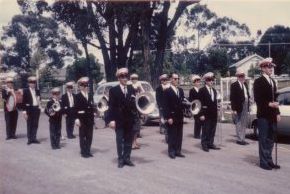
The Brass Band prepares for a local marching
engagement
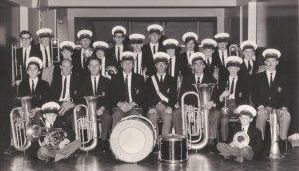
The Brass Band at Moorabbin in 1967
By 1967, the financial
situation of the Band had improved and the Shire of Croydon provided a
special grant of $515 to assist with the purchase of instruments. This
grant has continued in one form or another every year since that time,
both from the Shire of Croydon and more recently, the City of Maroondah.
Also in 1967, a ladies auxiliary was formed, which continued until the mid
1970s.
In 1969, Ralph Williamson resigned as Bandmaster due to ill health and was
replaced by Eric Page, a
graduate of the Royal Military School of Music (Kneller Hall) and music
teacher at Croydon High School. By the end of the decade, the Band was
functioning well and performing regularly in a wide variety of events
including concerts, contests and marching engagements.
In 1970, the Band moved to the
newly established Barngeong Reserve. The weatherboard building (a typical
army style bungalow) had been transported from elsewhere and the Band had
use of a rehearsal room and a storage room, which was most convenient. To
extend the storage space, the Band cut a hole in the roof of the building
and placed seldom used gear in the ceiling cavity.
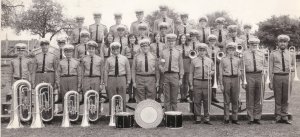
The Brass Band at Ballarat in 1970
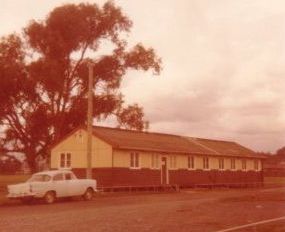
The band room at Barngeong Reserve
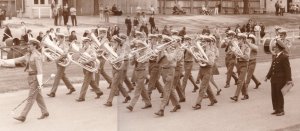
The Brass Band on the march
at Ballarat
The Croydon Concert Band Begins

The Australasian Bandsman was the official journal
of band associations in New
South Wales,
Queensland, South Australia and Victoria
1971 proved to be a busy year
for the Band, performing in public on twenty occasions and winning its
first contest in D Grade at the LaTrobe Valley Eisteddfod. In July 1971,
the organisation expanded through the formation of the Croydon Concert
Band. The idea for the Band came from a letter published in the March 1971
edition of the “Australasian Bandsman” in which it was explained how a
struggling brass band in South Australia had been turned into a thriving
concert band through the recruitment of local woodwind players who had
little or no outlet for their musical talents. The experiment had
evidently been a great success and the writer urged any other band in the
same situation to “give it a go”. In the case of the Croydon Citizens
Band, the Band was not struggling and the new Band was formed as an
additional ensemble. It was hoped that many Brass Band members would
choose to become part of the Concert Band and so gain experience in a
different form of ensemble. In addition, the Band proved to be an
excellent way for local young musicians, especially those being taught by
Eric Page at Croydon High School, to continue their musical endeavours
after graduating.
By the middle of 1972, the
Concert Band was fully established and under the direction of Eric Page,
had performed on four occasions. While the Band room was certainly large
enough for the Brass Band, the Concert Band found it quite a tight fit,
and the Band had to work hard to raise funds to purchase new music, music
stands and chairs. At the end of 1972, subscription fees were introduced
to stimulate members’ feelings of involvement and commitment and to
improve the financial situation of the organisation.
The Last Move (until the next one)
In May 1973, at the suggestion
of the Croydon City Council, the Bands moved to Keystone Hall which was
the original home of the Croydon (Youth) Club. The Bands have remained
there ever since, although considerable extensions to the building have
taken place over the years. The Bands’ storeroom was originally intended
as a garage where the local youth club could repair and maintain cars, and
the northern wall consisted only of steel mesh and a large steel mesh
gate. To assist the Bands, the Council provided bricks and the Band
provided the labour to replace the mesh with a brick wall and create a
store room suitable for the Bands’ purposes.
By the middle of 1973 the
Concert Band had been in existence for two years and had a membership of
about fifty people. The Band had purchased all of the major percussion
equipment required and about 70% of the Brass Band members also played in
the Concert Band. Soon after its formation, the Concert Band attended a
VBL Brass Band contest at the Malvern Town Hall to play for the audience
as a demonstration of the tone colours and repertoire of a concert band.
The Concert Band was the first such Band to register with the Victorian
Bands’ League and was eventually graded as an A Grade Band. During the
same period, the Brass Band purchased new uniforms consisting of dark blue
blazers and continued to appear at contests. The Brass Band also organised
and won its own D Grade contest at Croydon High School; another first!
A Dixieland and dance band called “The Ruptured Ducks” was formed and the
formation of chamber groups was also underway.
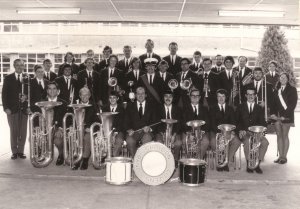
The Croydon Brass Band in Hobart, 1974
In 1974 the Croydon Citizens’
Band (the Brass Band) made its first interstate trip to compete at the
1974 Australian National Band Championships in Hobart. The trip was
financed by a successful fete held in and around Keystone Hall and was
regarded as the most significant achievement of the Band since its
formation. Mrs. Elaine Butler, who became a Life Member of the
organisation in 1979 was the Band Secretary and was particularly
responsible for the Hobart Trip.
During 1974, the Presidency of
the Band passed from Phil Baker to Doug Morison. Phil Baker had been
President since 1964 and during his ten years as President oversaw the
largest period of growth in the organisation, cementing the position of
the Croydon Citizens’ Band and overseeing the formation of the Croydon
Concert Band. During the same year, Eric Page resigned in order to move to
Western Australia. Jack Butcher became the Musical Director of the Brass
Band and Ian Viney, the Musical Director of the Concert Band.
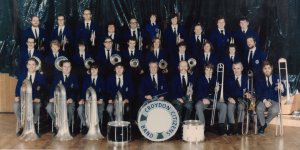
The Brass Band at Mornington in 1975
During this time, the Brass
Band shared a close relationship with the Wonthaggi Brass Band courtesy of
Doug Morison. Doug was transferred to Wonthaggi as part of his work with
the State Savings Band of Victoria, but continued to travel back to
Croydon for quite some time and fostered a close relationship between the
two Brass Bands. The Croydon Brass Band even visited the Wonthaggi Band
for a weekend and the combined bands marched and played in the main street
on Saturday, and played at Kernot outdoor market on the Sunday. There was
also a combined marching practice at the Bass Racecourse. Several
Wonthaggi Band members even registered with the Croydon Brass Band and
played with the Band at contests, most notably the 1978 Australian
National Band Championships at Kew, where Wonthaggi members can be seen
wearing uniforms with fancy gold braid in old band photos.
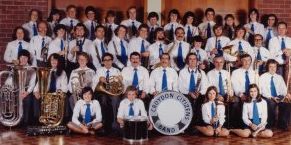
The Croydon Concert Band in 1978
During his tenure, Jack Butcher
(a National Champion on Flugel Horn on four occasions) raised the standard
of the Brass Band from 'D' to 'B' grade. Jack said he enjoyed his time at
Croydon, teaching junior players, and raising the general standard of the
Band. A particular highlight was winning the South Australian 'C' grade
championship in 1978 over eight other Bands and being placed third overall
in the own choice display marching. Jack left Croydon in 1980 and
moved to his beach home in Rye, and on leaving was made an Honorary Life
Member of Croydon Citizens' Bands. He was already an Honorary Life
Member of Malvern Band (1978). Jack went on to conduct the Shire of
Flinders Concert Band from 1982 to 1991 and formed the Southern Peninsula
Inter-Church Choir as well. In 1999, Jack was awarded a Medal of the Order
of Australia (OAM) for his service to the community through brass bands
and choirs.
_300.jpg)
The Brass Band in the late 1970s
Following Ian Viney, Hugh
Davies took over as Musical Director of the Concert Band in 1976 and was
involved in further developing the Band during his tenure, even taking the
Band to the Australian National Band Championships in Sydney in 1975 while
filling in for Ian Viney.
In 1979 the Concert Band began
marching practice, while continuing with its other activities. The ability
to carry out marching engagements helped to lessen the workload of the
Brass Band for this type of performance. As its first marching performance
the Concert Band took part in a Saturday morning parade through Croydon
and then marched in the Moomba Parade.
The Ups and Downs of the 80's
In 1981, Hugh was posted to
Kiribati (then the Gilbert and Ellis Islands) for 6 months with the Royal
Australian Air Force Central Band to assist the island to set up a Band
for their forthcoming independence celebrations. He later went back to
Kiribati for a further six months. Hugh was awarded life membership of the
Band on his departure in 1981. Upon his return to Victoria, Hugh took up a
position as Musical Director of the Sale City Band. The departure of Hugh
Davies led to the appointment of the Croydon Concert Bands’ longest
serving Musical Director, Richard O’Toole.
In 1983, the Croydon Citizens
Bands came of age and celebrated their 21st Birthday. In
recognition of the services provided to the community by the bands the
Shire of Croydon presented a conductor’s music stand to the organisation
which was inscribed with a plaque to mark the occasion.
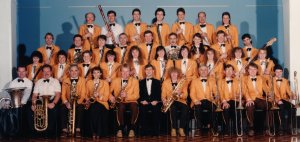
The Croydon Wind Symphony
at Box Hill in 1989
The Brass Band had a series of
conductors throughout the 1980s beginning with Merv Preusker, a National
Trombone Champion on six occasions, now playing with Hawthorn Band,
followed by Bob Boyle, Keith Symes, Brian Marsh, and Jack Harris. The
pressures of performing in B Grade and achieving results below
expectations, together with the short tenure periods (and possibly in some
cases the expectations of one or two musical directors) during this period
led to a decline in morale in the Brass Band. A number of players departed
as a result, while others left for unrelated reasons and due to low
numbers the Band eventually became unclassified due to a lack of
members.
Towards the Turn of the Century
During 1990 the Band attended
rehearsals of the Ringwood Band for a few weeks as our Brass Band had a
number of lower Brass players which complemented the Ringwood Band well as
they were short of players in this area. Ian Douglas, the Band President
at the time realised that this could easily spell the end for the Band if
the remaining members lost their association with the Croydon Brass Band.
The four remaining players came back to Croydon where they played through
the hymn book and rehearsed selected pieces suitable to their
instrumentation.
The Brass Band slowly rebuilt
in the following year under Michael Jongebloed, and even managed to return
to contest at the Latrobe Valley Eisteddfod. However, the Band was just
one player short of the required number of players required to officially
contest and played for adjudication purposes only. Michael Jonglebloed,
went on to become a partner in Music Junction Blackburn (now Billy Hydes
Music) was followed by Paul Barton as Musical Director who left after a
short period with the Band.
The Croydon Concert Band, on
the other hand, continued to prosper during the 1980s under the direction
of Richard O’Toole, who worked to maintain the standard of the Band in A
grade and put on a variety of concerts with artists such as Barry Crocker,
Donald Cant, Judi Connelli and many more. Richard left the Band in 1987 to
concentrate on the development of the Victorian State Youth Concert Band
and was made a Life Member of the organisation on his departure. Richard
was replaced by Bland Holt, an oboe player with the Australian Army Band
(Melbourne). At this time the Band did not contest to maintain its grading
and went down to B Grade. Bland left the Band in 1991 and Richard O’Toole
agreed to return for another stint as Musical Director between 1992 and
1996.
In the late 1980s the
organisation changed its name to the Croydon Citizens’ Bands, created a
new logo and formed a second concert band, which resulted in the name of
the original Concert Band changing to the Croydon Wind Symphony who are
now well known throughout the community and recently won its second
successive State Championship in B Grade.
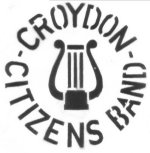

From old to new - logos of the
Croydon Citizens' Bands
The Croydon Wind Symphony
supported the Brass Band through these years and was instrumental in
keeping the organisation going. The Wind Symphony performed regularly,
staging its own concerts and performing in events for the Croydon City
Council.
The second Croydon Concert Band was re-established in 1988 and has
had several names during the 1990s including the Croydon Variety Band
and Croydon Junior Band, but it has now reverted to its original title.
This Band was initially conducted by Jack Harris,
before being taken over by John Tacey and then Sarah Gill. During its
early years, the Croydon Concert Band acted as a training Band for the
Wind Symphony and aimed to attract younger players. Also during this
period the Bands as a group became incorporated under law and much work
was done by John Tacey to finalise the new constitution of the Croydon
Citizens’ Bands Incorporated. Jack Harris continued this work by
formulating subsidiary bylaws.
The Brass Band recovered a
little before the appointment of Ken McColm in 1994, mainly due to the
hard work of local musician Alf Green who served with the Band until his
death in 1997. Alf and Ken were responsible for taking the Brass Band in
various new directions during his eight-year tenure. During his time, Ken
also took over the Croydon Concert Band, which became the Croydon Variety
Band. Under his leadership the Bands grew once again, with the Brass Band
returning to a membership of about 18 by the end of the 1990s and the
Variety Band having about twenty members at its peak in the mid 1990s.
The Brass Band competed for the first time in more than ten years at the
Latrobe Valley Eisteddfod in 2001.
The early 1990s was a period of
uncertainty for all the Bands as result of changes to local government
introduced by the Kennett State Government. In particular the Shire of
Croydon and City of Ringwood were combined to form the City of Maroondah,
and there was even some talk of the Ringwood and Croydon Bands having to
combine as well. Luckily, negotiations with the new Maroondah City Council
indicated that there was room enough for all the Bands, and the Maroondah
City Council remains incredibly supportive of all the Bands in
Maroondah.

The Maroondah City Council have
been strong supporters of the
Croydon Citizens' Bands
since the
formation of the Council in 1994
During 1994, the Croydon Wind
Symphony briefly formed the Croydon Show Band which performed only once at
the Croydon Festival at the beginning of 1995. This group was directed by
David Billimoria and was made up of Wind Symphony members. It rehearsed
after the Wind Symphony on Wednesdays, which made it difficult to
maintain.
At the end of 1996, Richard
O’Toole left the organisation to pursue other conducting interests and
particularly to form the Melbourne Rainbow Band, which has quickly
developed a reputation as one of the most versatile concert bands in
Melbourne and has toured through Victoria and the United States.
Sue Cook was appointed in mid
1997 as Musical Director of the Croydon Wind Symphony after a short stint
by David Billimoria as Musical Director. David was at that time (and still
is) the Assistant Musical Director of the Croydon Wind Symphony. Sue took
the Band to the Australian National Band Championships in 1998 where the
Band was placed fourth. The Band struggled during these years with
membership falling to about twenty-five members. However, the Brass and
Variety Bands were functioning reasonably well at this time and so the
situation of the Bands was somewhat reversed.
In 1998, the direction of the
Croydon Variety Band changed and focus was placed on junior players and
hence the Band was renamed the Croydon Junior Band. In particular, the
Band catered to players who were being taught by Ken McColm at local
primary schools and the Band quickly grew again to an active membership of
twelve.
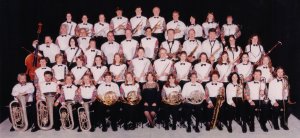
The Croydon Wind Symphony in 1998
The late 1990s also saw Ian
Douglas and David Billimoria heavily involved in the activities of the
Victorian Bands’ League Inc. Ian has been a member of the VBL Executive
Council since 1982 and served as President from 1995 to 1998 and now
continues as a Vice President. David Billimoria joined the Executive
Council in 1998 and was President of the Victorian Bands’ League from
October 2000 to October 2002.
Sue Cook left the Croydon Wind
Symphony at the start of 1999 and in August of that year, Andrew Mathers
was appointed as Musical Director after another short stint by David
Billimoria as Musical Director. Since Andrew’s appointment, enthusiasm in
the Band has grown and the Wind Symphony now has a regular membership of
over 40 members. This enthusiasm paid off when the Band won its first B
Grade state Championship in 2000.
In 2001, the Croydon Wind
Symphony celebrated its 30th Birthday in a combined concert
with the Southern Area Concert Band, which also turned thirty.
In that year, the Croydon
Citizens Bands changed once again with the departure of Ken McColm. The
resulting appointment of Melina Benger to the Brass Band is a happy one
for the Band as her father, Doug Morison, is a former President of the
organisation. Doug now conducts the Echuca Federal Band. The Croydon
Junior Band reverted to its original name of the Croydon Concert Band and
is now under the direction of Andrea Crompton, who has been a player in
the Croydon Wind Symphony since 1997. In addition, the Croydon Wind
Symphony celebrated its second successive State Championship in B Grade;
the contest was not held in 2001.
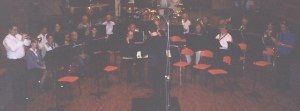
The Croydon Wind Symphony performs
in the
2002
Maroondah Community Concert Series
Premiere Concert, April 2002.
In its fortieth year, the
Croydon Citizens’ Bands Incorporated is now made up of three active
ensembles, The Croydon Brass Band, the Croydon Wind Symphony and the
Croydon Concert Band, and is actively supported by the Maroondah City
Council. The ensembles perform regularly at a variety of musical events
including concerts and competitions as well as events for the Maroondah
City Council such as the Maroondah Carols by Candlelight,
Maroondah Festival in the Foothills and ANZAC commemorations.
The Brass Band rehearses on Tuesday between 8.00pm and 10.00pm. The Concert Band rehearses at
6.30 pm on Wednesday. The Wind Symphony rehearses from 8.00pm on
Wednesday evenings. New members are always welcome.
To celebrate its fortieth
birthday, the Croydon Citizens’ Bands hosted the 2002 Maroondah
Community Concert Series.
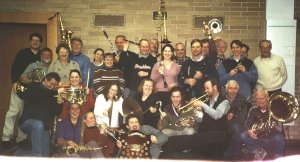
Members of the Croydon Wind Symphony
relax after winning the 2002
Victorian Concert Band Championships
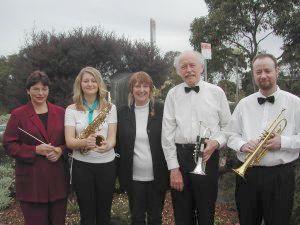
Members of the Bands (L-R:
Melina Benger,
Tamara Pearson,
Ian Douglas and
Phillip Lucas)
pose with
Cr. Marj Munro (centre)
from the Maroondah City Council
in preparation for the
Croydon Citizens' Bands 40th Birthday
Concert Celebration
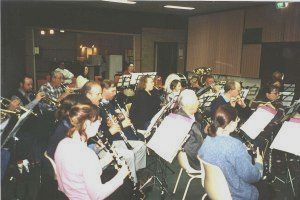
Members of the
Croydon Wind Symphony
in rehearsal (2002)
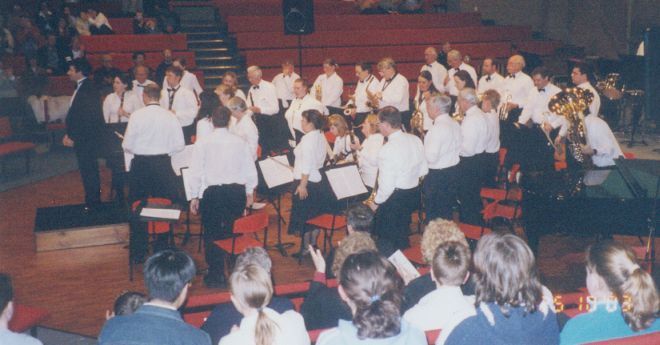
Croydon Wind Symphony in concert
October 2003,
Luther College
After forty years, there is no
sign of a mid life crisis. The Croydon Citizens’ Bands continue to
perform for the local community and are confident of continuing far into
the future.
(For more photos of band activities please see the Photos page.)

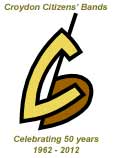










_300.jpg)









